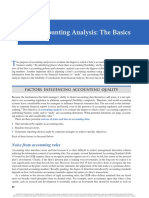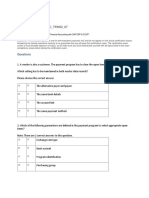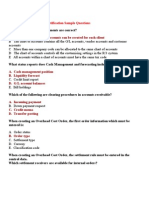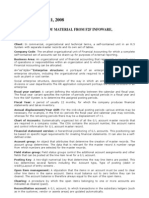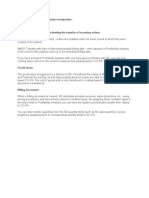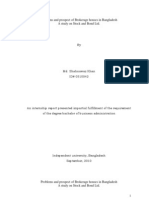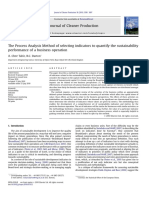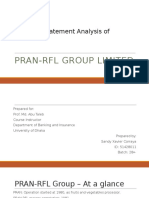0 ratings0% found this document useful (0 votes)
186 viewsBasic Configuration Settings For Implementing Asset Accounting in SAP 6.0
Basic Configuration Settings For Implementing Asset Accounting in SAP 6.0
Uploaded by
Jyotiraditya Banerjee8712817833
Copyright:
© All Rights Reserved
Available Formats
Download as DOCX, PDF, TXT or read online from Scribd
Basic Configuration Settings For Implementing Asset Accounting in SAP 6.0
Basic Configuration Settings For Implementing Asset Accounting in SAP 6.0
Uploaded by
Jyotiraditya Banerjee0 ratings0% found this document useful (0 votes)
186 views5 pages8712817833
Original Title
asset
Copyright
© © All Rights Reserved
Available Formats
DOCX, PDF, TXT or read online from Scribd
Share this document
Did you find this document useful?
Is this content inappropriate?
8712817833
Copyright:
© All Rights Reserved
Available Formats
Download as DOCX, PDF, TXT or read online from Scribd
Download as docx, pdf, or txt
0 ratings0% found this document useful (0 votes)
186 views5 pagesBasic Configuration Settings For Implementing Asset Accounting in SAP 6.0
Basic Configuration Settings For Implementing Asset Accounting in SAP 6.0
Uploaded by
Jyotiraditya Banerjee8712817833
Copyright:
© All Rights Reserved
Available Formats
Download as DOCX, PDF, TXT or read online from Scribd
Download as docx, pdf, or txt
You are on page 1of 5
At a glance
Powered by AI
The key takeaways are the basic configuration settings required for asset accounting in SAP such as defining depreciation areas, creating asset classes, assigning charts of depreciation, and maintaining depreciation keys.
The main steps to configure asset accounting in SAP are defining charts of depreciation, assigning charts of depreciation to company codes, creating asset classes, maintaining depreciation keys, specifying account assignments, and determining depreciation areas in asset classes.
Depreciation keys in asset accounting contain the calculation methods for depreciation and parameters that control ordinary depreciation, special depreciation, and scrap value.
Narayan Jyotiraditya Banik Bala,
©8712817833/9775788328
FIXED ASSET
Basic Configuration settings for implementing Asset
Accounting in SAP 6.0
INTRODUCTION:
The asset accounting module in SAP is one where the accounting
pertaining to fixed assets is done. These include transactions like
acquisition of fixed assets, sale of fixed assets, in-house development of
assets, settlement of WIP, and accounting for depreciation on fixed assets
and so on.
A separate Asset Accounting Module is required for these transactions
because there are some distinguishing characteristics of fixed assets as
compared to normal General Ledger accounts.
Some of these characteristics of fixed assets which necessitate a separate
Asset accounting module, are given below :
- Fixed assets have a life span exceeding one year. But they are subject to wear
and tear, and to provide for this we need to depreciate them. The Asset Accounting
Module enables such calculation of depreciation (we can create depreciation keys
where we give the rate of depreciation). Such feature is not there in the normal GL
Accounting.
- Fixed assets must be shown as a separate head in the balance sheet of
companies, and that too under broad categories. Example : Land, Plant and Machinery
etc. In the Asset Accounting Module, we can categorize individual fixed assets into
asset classes, and thus we can meet this requirement. In other words, classification of
fixed assets for balance sheet disclosure purposes becomes easy.
- Sometimes we may have self-constructed fixed assets which are categorized as
WIP in construction stage. These must be settled from WIP to normal GL accounts
after construction. This facility of settlement is provided by the Asset accounting
module.
- The management may require different reports pertaining to fixed assets like
asset history report, report of fixed assets cost center wise etc, which are readily
available in the Asset Accounting Module.
- Apart from this some other features like assets planned values, calculation of
insurance value, physical inventory data etc. are possible in asset accounting.
In order to set up the asset accounting module in SAP, some configuration needs to be
done in IMG. This includes setting up the organization structure, defining the
depreciation areas, creating the different asset classes, account assignment, defining
depreciation keys and so on. All these configuration settings has been discussed
below:
1) Chart of Depreciation: A chart of depreciation is a
directory of depreciation areas arranged according to business
requirements. Each chart of depreciation contains the rules for
the evaluation of assets that are valid in a specific country or
economic area.
Each company code defined in Asset Accounting must refer to a
chart of depreciation.
Copy reference Chart of Depreciation: SAP provides country-
specific charts of depreciation with predefined depreciation areas.
These charts of depreciation are only references for customer
charts of depreciation and therefore, cannot be used directly.
When you create your own chart of depreciation, you must copy
a reference chart of depreciation. Once the
same is copied, give the required description to the
newly created Chart of Depreciation.
Transaction Code: EC08
IMG Menu Path: Financial Accounting (New) à Asset Accounting à Organizational
Structures à Copy Reference Chart of Depreciation/Depreciation Areas à Copy
Reference Chart of Depreciation
2) Define Chart of Depreciation and depreciation areas: You can change the
definition of the depreciation areas that were copied from the standard depreciation
plan, and add additional depreciation areas if required:
Transaction Code: OADB
IMG Menu Path: Financial Accounting (New) à Asset Accounting à Organizational
Structures à Copy Reference Chart of Depreciation/Depreciation
Areas à Copy/Delete Depreciation Areas
3) Assign Chart of Depreciation to Company code: When you assign a Chart of
Depreciation, you assign a Company code for asset accounting.
Transaction Code: OAOB
IMG Menu Path: Financial Accounting (New) à Asset Accounting à Organizational
Structures à Assign Chart of Depreciation to Company Code
4) Asset Classes: Asset classes are the most important structuring elements for
fixed assets. You can define any number of asset classes in the system. You can use
them to structure your fixed assets according to different criteria. Asset class controls
asset master data. Many values are derived from asset class while creating the master
data. Example : Asset number, GL accounts, screen layouts are derived from asset class.
Further it provides default depreciation keys while creating the master data.
Individual assets must compulsorily be assigned to an asset class at time of creating
them, e.g. A Table purchased may be booked as a individual asset linked to an asset
class "Furniture". As given earlier, companies are required to classify their assets in the
balance sheet into different broad heads, and asset classes may be created to suit
these. Based on asset classes, we also assign the account assignment for various
transactions pertaining to that asset class.
Transaction Code: OAOA
IMG Menu Path: Financial Accounting (New) à Asset Accounting à Organizational
Structures à Asset Classes à Define Asset Classes
5) Specify Account Determination: The most important function of an asset class
is to link asset master records to their respective general ledger accounts in Financial
Accounting. This link is created by the account determination key in each asset class.
You can assign several asset classes to the same account determination key.
Transaction Code: SPRO
IMG Menu Path: Financial Accounting (New) à Asset Accounting à Organizational
Structures à Asset Classes à Specify Account Determination
6) Create Screen Layout Rules: Screen Layout rules are created to make it easier to
maintain the asset master data as the asset master contains a large number of fields
which are used for different purposes.
Transaction Code: SPRO
IMG Menu Path: Financial Accounting (New) à Asset Accounting à Master
Data à Screen Layout à Define Screen Layout for Asset Master Data à Create Screen
Layout Rules for Asset Master Record
7) Number Assignment Across Company Codes: In Asset Accounting you can
assign the main asset number on the basis of cross-company codes.
Transaction Code: AO11
IMG Menu Path: Financial Accounting (New) à Asset Accounting à Organizational
Structures à Specify Number Assignment Across Company Codes
8) Define how depreciation areas post to General Ledger: This setting will
determine how the depreciation areas post their APC transactions and/or depreciation
to the GL. SAP can post the APC transactions of one depreciation area to the general
ledger online automatically. Usually this is the book depreciation area 01. For the rest,
transactions to the general ledger can be posted automatically using periodic
processing.
Transaction Code: OADX
9) Assign the General Ledger Accounts: Account determination is a set where GL
accounts are assigned to post asset acquisition, retirement & depreciation based on
various business process scenario. These account determinations are then assigned to
asset classes to derive & control GL postings pertain to the asset class. Here we give the
Chart of account wise General Ledger Account determination for various asset
accounting transactions, like acquisition, gain/loss on sale, ordinary depreciation etc.
Transaction Code: AO90
10) Specify the Financial Statement Version for Asset Reports: This
defines which financial statement version should SAP use for each depreciation area as
a default. This default applies when the financial statement version is contained in the
sort version used for a given report.
Transaction Code: OAYN
Specify Account Assignment Types for Account Assignment Objects: Here we can
define how the controlling area posting of cost required for each asset transaction type.
We configure the account assignment objects that can be posted based on :
- The transaction type, and
- Account assignment type
IMG Menu Path: Financial Accounting à Asset Accounting à Integration with the
General Ledger à Additional Account Assignment objects -> Specify account
assignment types for account assignment objects
11) Assign Tax code for non-taxable transactions: Here we give the
input/output tax code which is used when posting non-taxable transactions to tax-
relevant accounts from the Accounting interface. As an alternative, it is possible to set
an indicator in the G/L account master record which permits transactions "not relevant
to tax" to be posted even without a tax code.
Transaction Code: OBCL
12) Assign settlement profile: The settlement profile includes settings on the allowed
receivers of the settlement. We can give settlement profile 10 to enable settlement to
all receivers. The settlement profile is applicable to assets under construction.
Transaction Code: OAAZ
13) Maintain Depreciation keys & activate them: Depreciation keys contain the
calculation methods for depreciation calculation and parameters that control :
- Ordinary depreciation
- Special depreciation
- Scrap value (cutoff value)
Transaction Code: AFAMA
14) Specify document type for posting depreciation: Here we give the accounting
document type to be used in depreciation postings, for the company code.
Transaction Code: AO71
15) Specify Intervals & Posting Rules: Here we specify the depreciation areas for
which the depreciation is posted to the general ledger during the depreciation run. We
specify if the period for depreciation posting in the run is monthly, bi-monthly,
quarterly etc.
Transaction Code: OAYR
16) Determine Depreciation Areas in the Asset Class: Here, asset classes are assigned
default values for the depreciation key and useful life. These values are defaulted
whenever postings to assets of these classes is done.
Transaction Code: OAYZ
I hope this will help the readers with the basic settings required for configuring Asset
Accounting in SAP 6.0.
You might also like
- WallStreetPrep RedBook PDFDocument285 pagesWallStreetPrep RedBook PDFenri83% (46)
- Business Analysis and Valuation IFRS Edition 3rd Ed - RemovedDocument48 pagesBusiness Analysis and Valuation IFRS Edition 3rd Ed - RemovedAthira Khairunnisa100% (1)
- C TFIN52 67 Sample Questions10082016bDocument5 pagesC TFIN52 67 Sample Questions10082016bnamank005No ratings yet
- Narayan Jyotiraditya Bala Banik Configuration Steps: Main Customizing ActivitiesDocument20 pagesNarayan Jyotiraditya Bala Banik Configuration Steps: Main Customizing ActivitiesJyotiraditya BanerjeeNo ratings yet
- Wiley Notes Part 2 PDFDocument183 pagesWiley Notes Part 2 PDFEdward Joseph Mabborang CaronanNo ratings yet
- 05 ALCAR ApproachDocument25 pages05 ALCAR ApproachVaidyanathan Ravichandran100% (2)
- Sap FiDocument4 pagesSap FiNicky AugustineNo ratings yet
- Asset Qns and Ans For Interview Practice PDFDocument15 pagesAsset Qns and Ans For Interview Practice PDFMOORTHYNo ratings yet
- GL, AP, AR, Cash Journal and R3Document10 pagesGL, AP, AR, Cash Journal and R3sanjaypoptani.mclindiaNo ratings yet
- Dunning Procedure in SAP S - 4HANADocument91 pagesDunning Procedure in SAP S - 4HANAmohammad.khaseem39No ratings yet
- SAP Controlling Simplified: Mohammed RashidDocument13 pagesSAP Controlling Simplified: Mohammed RashidSUNNY LUNKERNo ratings yet
- ImportantDocument8 pagesImportantsurendraNo ratings yet
- Sap Basis TcodesDocument13 pagesSap Basis Tcodesnkhlr7No ratings yet
- Document SplittingDocument4 pagesDocument SplittingAjeesh SudevanNo ratings yet
- Finance Terms in FIDocument4 pagesFinance Terms in FIJitendra KatiyarNo ratings yet
- Automatic Account DeterminationDocument13 pagesAutomatic Account DeterminationPraveen KumarNo ratings yet
- THD - Document Splitting ConfigurationDocument16 pagesTHD - Document Splitting ConfigurationNaresh Kumar100% (1)
- Sappress - Segment - Reporting (Sample) PDFDocument13 pagesSappress - Segment - Reporting (Sample) PDFomiconNo ratings yet
- Lockbox SAPDocument23 pagesLockbox SAPJayanth MaydipalleNo ratings yet
- FICA1Document8 pagesFICA1alexisNo ratings yet
- FI Account Determination / CO Account AssignmentDocument4 pagesFI Account Determination / CO Account AssignmentGurmi100No ratings yet
- Bill of Exchange Sent For CollectionDocument7 pagesBill of Exchange Sent For Collectionmehar mNo ratings yet
- How To Create and Configure DME File: Skip To End of MetadataDocument3 pagesHow To Create and Configure DME File: Skip To End of Metadatasrinivas kalakuntlaNo ratings yet
- 03 - Business TransactionDocument28 pages03 - Business TransactionLeandro Faria100% (1)
- Integration Point of MM-FI & SD-FI in SAP ERPDocument7 pagesIntegration Point of MM-FI & SD-FI in SAP ERPsaikumar satyaNo ratings yet
- F150: Dunning Via OM - On Premise RestrictionsDocument13 pagesF150: Dunning Via OM - On Premise RestrictionsSANTOSH KUMAR SHARMANo ratings yet
- New Asset AccountingDocument8 pagesNew Asset AccountingUJ21No ratings yet
- TCODE - 2KES PCA Balance Carry ForwardDocument8 pagesTCODE - 2KES PCA Balance Carry ForwardrajdeeppawarNo ratings yet
- Useful SAP System TransactionsDocument9 pagesUseful SAP System TransactionsRafael FeherNo ratings yet
- Foreign Currency ValuationDocument7 pagesForeign Currency Valuationanon_996613481No ratings yet
- Vvemula - Blogspot.in-Interview Questions and Answers For SAP Accounts ReceivableDocument11 pagesVvemula - Blogspot.in-Interview Questions and Answers For SAP Accounts ReceivableLakshmipathi NaraNo ratings yet
- BOE & AR INT CalculationsDocument35 pagesBOE & AR INT CalculationsAman IamtheBestNo ratings yet
- Cross-System Depreciation AreaDocument3 pagesCross-System Depreciation AreaSuryanarayana TataNo ratings yet
- Prerequisites: Parallel Accounting Using LedgersDocument4 pagesPrerequisites: Parallel Accounting Using LedgersjksdjkfhksjdhfNo ratings yet
- BH FICO TcodesDocument40 pagesBH FICO TcodesBhaskar Rao KapuNo ratings yet
- FI AA Periodic ProcessingDocument25 pagesFI AA Periodic ProcessingcecileekoveNo ratings yet
- Opening and Closing Posting Periods More Flexibly PDFDocument5 pagesOpening and Closing Posting Periods More Flexibly PDFRajeshNo ratings yet
- Base Method-FI AADocument4 pagesBase Method-FI AAGanesh RameshNo ratings yet
- PV PPT DIGITAL WALLET LatestDocument56 pagesPV PPT DIGITAL WALLET Latestravi dasariNo ratings yet
- Sap B1 - FinancialsDocument7 pagesSap B1 - FinancialsRhon Ryan TamondongNo ratings yet
- SAP Withholding Tax Configuration StepsDocument1 pageSAP Withholding Tax Configuration StepsNic NgNo ratings yet
- Answers For SAP FI/CO Certification Sample Questions: A More Than One Chart of Accounts Can Be Created For Each ClientDocument67 pagesAnswers For SAP FI/CO Certification Sample Questions: A More Than One Chart of Accounts Can Be Created For Each Clientkcv004No ratings yet
- Foreign Currency TranslationDocument2 pagesForeign Currency TranslationJamella Brequillo100% (1)
- Sap Helpful Reports ListDocument18 pagesSap Helpful Reports ListShaziaIqbalNo ratings yet
- Wednesday, June 11, 2008: Sap Fico Free Study Material From F2F Infoware, BangaloreDocument7 pagesWednesday, June 11, 2008: Sap Fico Free Study Material From F2F Infoware, Bangaloreanuradha9787No ratings yet
- Statistical Key FiguresDocument2 pagesStatistical Key FiguresfharooksNo ratings yet
- FF7A Cash PositionDocument9 pagesFF7A Cash PositionOkikiri Omeiza RabiuNo ratings yet
- Sap Fico CourseDocument12 pagesSap Fico CourseRajashekar ReddyNo ratings yet
- Below Are The Changes RequestedDocument2 pagesBelow Are The Changes RequestedAjay KumarNo ratings yet
- F.07 Carry Forward Receivables - PayablesDocument4 pagesF.07 Carry Forward Receivables - PayableshenriqueNo ratings yet
- Back To The Basics - : Account Amount Profit CentreDocument14 pagesBack To The Basics - : Account Amount Profit CentreReddy BDNo ratings yet
- What Is Special GL TransactionDocument4 pagesWhat Is Special GL TransactionRaj ShettyNo ratings yet
- Collection ManagementDocument34 pagesCollection ManagementRaju50% (2)
- 1.what Is SAP Finance? What Business Requirement Is Fulfilled in This Module?Document163 pages1.what Is SAP Finance? What Business Requirement Is Fulfilled in This Module?sudhakarNo ratings yet
- Search String - Part 1Document5 pagesSearch String - Part 1Kenisha KhatriNo ratings yet
- Residual Method - Incoming & Outgoing Partial Payments Posting in SAPDocument6 pagesResidual Method - Incoming & Outgoing Partial Payments Posting in SAPrune 00No ratings yet
- Bank ReconciliationDocument43 pagesBank ReconciliationKenisha KhatriNo ratings yet
- Public Cloud ERP for Small or Midsize Businesses A Complete Guide - 2019 EditionFrom EverandPublic Cloud ERP for Small or Midsize Businesses A Complete Guide - 2019 EditionNo ratings yet
- Start: Vendor Business Process Customer Business ProcessDocument6 pagesStart: Vendor Business Process Customer Business ProcessJyotiraditya BanerjeeNo ratings yet
- Table Name: Description Important FieldsDocument5 pagesTable Name: Description Important FieldsJyotiraditya Banerjee100% (1)
- Unit ID Unit Description Unit Sub-Unit IDDocument9 pagesUnit ID Unit Description Unit Sub-Unit IDJyotiraditya BanerjeeNo ratings yet
- Copa Flows From SD Has 3 Main TouchpointsDocument1 pageCopa Flows From SD Has 3 Main TouchpointsJyotiraditya BanerjeeNo ratings yet
- AR & AP Regrouping in SAP (S/4 HANA Finance) : # Purpose of The ArticleDocument8 pagesAR & AP Regrouping in SAP (S/4 HANA Finance) : # Purpose of The ArticleJyotiraditya BanerjeeNo ratings yet
- Automatic AUC CreationDocument10 pagesAutomatic AUC CreationJyotiraditya BanerjeeNo ratings yet
- Copa Flows From SD Has 3 Main TouchpointsDocument1 pageCopa Flows From SD Has 3 Main TouchpointsJyotiraditya BanerjeeNo ratings yet
- Asset Under Construction Linked With Internal Order Process High Level StepsDocument17 pagesAsset Under Construction Linked With Internal Order Process High Level StepsJyotiraditya Banerjee100% (1)
- Jyotiraditya: Erp Business SchoolDocument13 pagesJyotiraditya: Erp Business SchoolJyotiraditya BanerjeeNo ratings yet
- Toatal Spent 5000 900 Gas 500 Shoes 5000 1600 Hotel 2500 Puja 900 Bus Sri Kalahasthi To Banaglore 1200 Bus Banaglore To KalahasthiDocument1 pageToatal Spent 5000 900 Gas 500 Shoes 5000 1600 Hotel 2500 Puja 900 Bus Sri Kalahasthi To Banaglore 1200 Bus Banaglore To KalahasthiJyotiraditya BanerjeeNo ratings yet
- GST Training SAP Axem Consulting Services LLPDocument92 pagesGST Training SAP Axem Consulting Services LLPJyotiraditya BanerjeeNo ratings yet
- AssetdescriptionDocument1 pageAssetdescriptionJyotiraditya BanerjeeNo ratings yet
- Central Finance Exploits The Capabilities of HANA IDocument3 pagesCentral Finance Exploits The Capabilities of HANA IJyotiraditya BanerjeeNo ratings yet
- Jyotiraditya Banik 8712817833: Asset Disposal - Sales To A Customer: F-92 - With CustomerDocument3 pagesJyotiraditya Banik 8712817833: Asset Disposal - Sales To A Customer: F-92 - With CustomerJyotiraditya BanerjeeNo ratings yet
- Central Finance: Aditya 8712817833Document17 pagesCentral Finance: Aditya 8712817833Jyotiraditya BanerjeeNo ratings yet
- New GL: Jyotiraditya.B 8712817833Document12 pagesNew GL: Jyotiraditya.B 8712817833Jyotiraditya BanerjeeNo ratings yet
- AssetdescriptionDocument1 pageAssetdescriptionJyotiraditya BanerjeeNo ratings yet
- Rel - My SAP CO Material FullDocument284 pagesRel - My SAP CO Material FullJyotiraditya Banerjee100% (1)
- Sap PPT 1Document26 pagesSap PPT 1Jyotiraditya BanerjeeNo ratings yet
- Asset AccountingDocument26 pagesAsset AccountingJyotiraditya BanerjeeNo ratings yet
- Foreign Currency ValuationDocument19 pagesForeign Currency ValuationJyotiraditya BanerjeeNo ratings yet
- SAP New GL AccountingDocument120 pagesSAP New GL AccountingJyotiraditya Banerjee100% (1)
- Compart2024acc Set3Document20 pagesCompart2024acc Set3giriayush219No ratings yet
- GLOBUSSPR - Investor Presentation - 16-Jun-21 - TickertapeDocument29 pagesGLOBUSSPR - Investor Presentation - 16-Jun-21 - Tickertapepiyush rohiraNo ratings yet
- 8414 Unit 2 MCQsDocument19 pages8414 Unit 2 MCQsishaansar25No ratings yet
- AdsadsdDocument28 pagesAdsadsdTong Wilson60% (5)
- Problems and Prospect of Brokerage Houses in BangladeshDocument29 pagesProblems and Prospect of Brokerage Houses in BangladeshAkter Uz ZamanNo ratings yet
- 3 Aa SDocument6 pages3 Aa SYate ManjuNo ratings yet
- Product MixDocument4 pagesProduct MixGeoffrey MaliyaNo ratings yet
- CT - Maf253 Q Jan2017Document6 pagesCT - Maf253 Q Jan2017Nur Anis AqilahNo ratings yet
- SMEDA Internet CafeDocument15 pagesSMEDA Internet Cafemax_slam100% (4)
- P.a.M SustainabillityDocument10 pagesP.a.M SustainabillityGarion CharlesNo ratings yet
- It 11 GaDocument8 pagesIt 11 GaSadav ImtiazNo ratings yet
- Mass Rapid Transit Operation & Maintenance Cost Calculation ModelDocument6 pagesMass Rapid Transit Operation & Maintenance Cost Calculation ModelJOYDIP PRODHANNo ratings yet
- Financial Statement Analysis of Pran-RFL Group LimitedDocument9 pagesFinancial Statement Analysis of Pran-RFL Group LimitedSandy Xavier80% (5)
- Personal Finance Canadian Canadian 6th Edition Kapoor Test BankDocument8 pagesPersonal Finance Canadian Canadian 6th Edition Kapoor Test BankDrAnnaHubbardDVMitaj100% (45)
- 2016 Special Olympics Missouri Annual ReportDocument8 pages2016 Special Olympics Missouri Annual ReportSOMissouriNo ratings yet
- Ifrs 1 7 & IF RIC 12: Insur Ance Cont Ract S& Servi Ce Co Ncess ION Arra Ngem EntsDocument78 pagesIfrs 1 7 & IF RIC 12: Insur Ance Cont Ract S& Servi Ce Co Ncess ION Arra Ngem EntsGeneva OnsatNo ratings yet
- The Ontology and Epistemology of Social Reality in Accounting According To MattessichDocument9 pagesThe Ontology and Epistemology of Social Reality in Accounting According To MattessichfemisagoNo ratings yet
- Depreciation MCQDocument10 pagesDepreciation MCQamitsukhija2009No ratings yet
- 5 Year Financial PlanDocument26 pages5 Year Financial PlanNaimul KaderNo ratings yet
- A Project Report Sales AnalysisDocument71 pagesA Project Report Sales Analysisayushchawla681No ratings yet
- Reviewer Acc111Document5 pagesReviewer Acc111Desiree Nicole ReyesNo ratings yet
- Warning: Rating: 18+ All Images Courtesy of Beate Uhse Annual ReportDocument32 pagesWarning: Rating: 18+ All Images Courtesy of Beate Uhse Annual Reportmarivas2388No ratings yet
- Employee Benefit - 181121Document26 pagesEmployee Benefit - 181121KhansaFatinNo ratings yet
- Bibek Pashu Tatha Machha PalanDocument44 pagesBibek Pashu Tatha Machha PalanBIBUTSAL BHATTARAINo ratings yet
- FMA Question PackDocument67 pagesFMA Question PackAhamed NabeelNo ratings yet
- Financial Statement Analysis - NestleDocument16 pagesFinancial Statement Analysis - NestleSreeda Perikamana0% (1)

